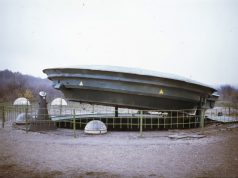Poltava is a great city with a great history. We remember this city as the one where Ukrainian history and culture were born, and one that gave to Ukraine geniuses whose names will remain forever etched in history. The picturesque landscapes and incomparable spirit of Poltava and the Poltava region have touched the souls of classes writers such as Ivan Kotlyarevsky, Nikolai Gogol, Taras Shevchenko and Alexander Pushkin. There are many reasons why Poltava is a perfect place to go if you want to explore Ukrainian history and culture.
The first thing that you have to know is that the city of Poltava is quite small, but don’t let this make you think that there are no special sites to see or stories to hear. In fact, the compact size of the city is an advantage if you don’t enjoy spending a lot of time driving from one destination to another, or if you just don’t have a lot of time on your hands. Starting from the main landmark, which is the Krugla Ploscha (Round Square), you can confidently walk towards the Soborniy Maidan (Cathedral Square) where you will find Uspensky Cathedral, the famous Poltava Galuska monument and the oldest church in the Poltava region — the Savior Orthodox Church. Some of the other significant cultural and historical sights are the White Arbor, Ivanov’s Mountain and the Peasant Bank.
Of course, we should not forget that another important aspect of traveling is getting to know the people who live in a city. Their temperament and relative level of hospitality will give you a more complete impression of the place that you are visiting. And if you rate Poltava by its citizens, there is a good possibility that the city might get your highest score. The people of Poltava are typically kind, friendly and will always tell you about more remarkable places to see are they are very proud of being locals. Not every city can brag about its green spaces — but in Poltava the ample number of parks and gardens will surprise you. So if you are considering a visit to Poltava, then perhaps it’s best to book your trip in the spring or summer and take in the beautiful scenery and, of course, visit Poltava’s arboretum!
Even if you are not interested in city sightseeing or nature however, there are many other things to do! Poltava is also known for its many museums. These include the Museum of Poltava Battle, Museum-Estate of Ivan Kotlyarevsky, Poltava Local History Museum, Memorial Literature Museum and Museum-Estate of Panas Mirny, Museum of Space and Aviation… The list can go on, but if you have to pick just one, visit the Poltava Art Museum. The Museum Collection is based on the works of the Poltava-born artist Nikolay Yaroshenko. Despite the destruction of a major part of the collection during World War II, the doors of Poltava Art Museum are still open for city visitors. The museum will amaze you with strong pieces from the masters that include Clara Peters, Marcello Bacciarelli, Ivan Shishkin, Francesco Guardi, Ivan Repin. In case you want to learn more about the contemporary art life of Poltava, there is also a new platform for young artists called Jump Art Gallery, which boasts rotating exhibitions..
Poltava inspires not only artists but also writers. The city’s surrounding area was dearly loved and described with tenderness by one of the most mysterious authors of the nineteenth century — Nikolai Gogol. Poltava in turn remembers his name with affection and honor. While walking in the city, your attention may be drawn by a beautiful building with columns: it is the N. V. Gogol Theater, a special place with a unique history. Nowadays, the stage of the Theater presents modern and classical repertoire, but some of the most popular events it hosts are concerts of the Poltava Symphonic Orchestra.
Gogol’s memory survives not only in the city — you can find echoes of the author’s life in many places around the Poltava region. For example, the Museum-Reserve of N. V. Gogol is the renovated estate of the Gogol-Yanovsky family, which is located in Vasilievka Village (modern Gogolevo). This is the place where Gogol grew up and got to know all the specifics of Ukrainian tradition and historical rites. Even when the writer had moved to Saint-Petersburg, he managed to continue his relationship with the the culture of his home through letters he exchanged with his mother.
Another trip worth making is to a settlement with the well-known name of Dikanka, a vibrant place that teaches us about the life of the Kochubeys. There you will find the triumphal arch, the Church of St. Nicholas, the Kochubey Burial Vault and the Holy Trinity Church. In the heart of Dikanka there are two very special places: four six-hundred-year-old oaks and a lilac grove. There is a legend that the grove was planted with various kinds of lilac flowers for one of the Kochubey daughters who had an incurable disease. Since then, during the time of the grove’s blossoming, Dikanka celebrates “The Songs of the Lilac Grove,” an unforgettable event for the settlement’s visitors.
Poltava is a beautiful and significant place. It is filled with memories of a distant past, but still makes you feel at home. Sadly, you won’t find Poltava on the list of Ukrainian must-see cities. Not everyone will be able to discover the magnificent places and appreciate the joyful spirit of this city. Still, if you do decide to visit Poltava in order to see everything with your own eyes, then you will be warmly welcomed and generously rewarded for your curiosity.




































